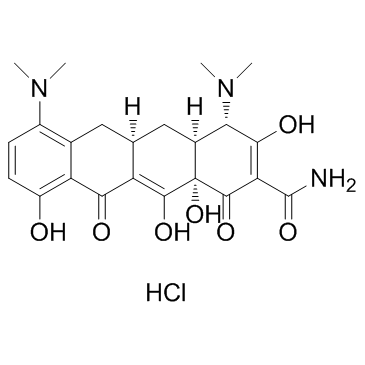Minocycline hydrochloride

Minocycline hydrochloride structure
|
Common Name | Minocycline hydrochloride | ||
|---|---|---|---|---|
| CAS Number | 13614-98-7 | Molecular Weight | 493.937 | |
| Density | N/A | Boiling Point | 659.4ºC at 760mmHg | |
| Molecular Formula | C23H28ClN3O7 | Melting Point | 205-210° (dec) | |
| MSDS | Chinese USA | Flash Point | 352.6ºC | |
|
Microglia disrupt mesolimbic reward circuitry in chronic pain.
J. Neurosci. 35 , 8442-50, (2015) Chronic pain attenuates midbrain dopamine (DA) transmission, as evidenced by a decrease in opioid-evoked DA release in the ventral striatum, suggesting that the occurrence of chronic pain impairs reward-related behaviors. However, mechanisms by which pain mod... |
|
|
Heat stress-induced memory impairment is associated with neuroinflammation in mice.
J. Neuroinflammation 12 , 102, (2015) Heat stress induces many pathophysiological responses and has a profound impact on brain structure. It has been demonstrated that exposure to high temperature induces cognitive impairment in experimental animals and humans. Although the effects of heat stress... |
|
|
CB1 and CB2 cannabinoid receptor antagonists prevent minocycline-induced neuroprotection following traumatic brain injury in mice.
Cereb. Cortex 25(1) , 35-45, (2014) Traumatic brain injury (TBI) and its consequences represent one of the leading causes of death in young adults. This lesion mediates glial activation and the release of harmful molecules and causes brain edema, axonal injury, and functional impairment. Since ... |
|
|
Efficacy of single-dose chemotherapy (rifampicin, ofloxacin and minocycline-ROM) in PB leprosy patients with 2 to 5 skin lesions, India: randomised double-blind trial.
Indian J. Lepr. 84(3) , 195-207, (2012) We conducted randomized double-blind trial for single-dose of Rifampicin, Ofloxacin and Minocycline (ROM) compared to WHO-PB-MDT among paucibacillary (PB) leprosy patients with 2-5 skin lesions. We enrolled 1526 patients from five centres (ROM=762; WHO-PB-MDT... |
|
|
Mechanisms of mitochondrial damage in keratinocytes by pemphigus vulgaris antibodies.
J. Biol. Chem. 288(23) , 16916-25, (2013) The development of nonhormonal treatment of pemphigus vulgaris (PV) has been hampered by a lack of clear understanding of the mechanisms leading to keratinocyte (KC) detachment and death in pemphigus. In this study, we sought to identify changes in the vital ... |
|
|
Mechanistic analysis of PLGA/HPMC-based in-situ forming implants for periodontitis treatment.
Eur. J. Pharm. Biopharm. 94 , 273-83, (2015) In-situ forming implant formulations based on poly(lactic-co-glycolic acid) (PLGA), acetyltributyl citrate (ATBC), minocycline HCl, N-methyl pyrrolidone (NMP) and optionally hydroxypropyl methylcellulose (HPMC) were prepared and thoroughly characterized in vi... |
|
|
Microglia regulate the number of neural precursor cells in the developing cerebral cortex.
J. Neurosci. 33(10) , 4216-33, (2013) Neurogenesis must be properly regulated to ensure that cell production does not exceed the requirements of the growing cerebral cortex, yet our understanding of mechanisms that restrain neuron production remains incomplete. We investigated the function of mic... |
|
|
Real-time monitoring of the metabolic activity of periodontopathic bacteria.
J. Microbiol. Methods 115 , 22-6, (2015) Bacterial metabolic activity is associated with the onset and progression mechanisms of oral biofilm-mediated disease; however, at present no method to monitor bacterial metabolism exists, especially for periodontopathic bacteria. Therefore, we aimed to estab... |
|
|
Inhibition of microglial activity alters spinal wide dynamic range neuron discharge and reduces microglial Toll-like receptor 4 expression in neuropathic rats.
Clin. Exp. Pharmacol. Physiol. 42 , 772-9, (2015) It is believed that neuropathic pain results from aberrant neuronal discharges although some evidence suggests that the activation of glia cells contributes to pain after an injury to the nervous system. This study aimed to evaluate the role of microglial act... |
|
|
RNA Sequencing of Tumor-Associated Microglia Reveals Ccl5 as a Stromal Chemokine Critical for Neurofibromatosis-1 Glioma Growth.
Neoplasia 17 , 776-88, (2015) Solid cancers develop within a supportive microenvironment that promotes tumor formation and growth through the elaboration of mitogens and chemokines. Within these tumors, monocytes (macrophages and microglia) represent rich sources of these stromal factors.... |